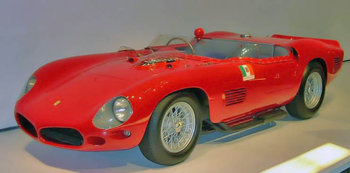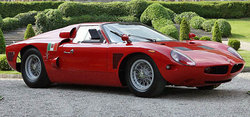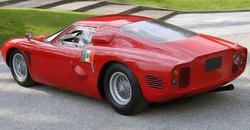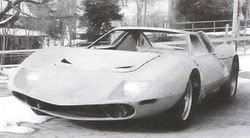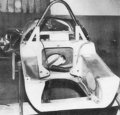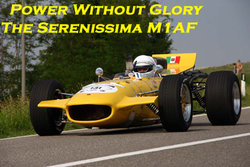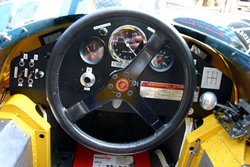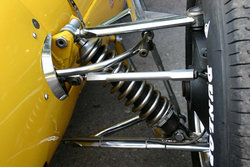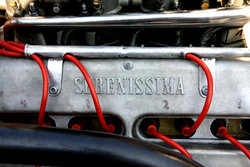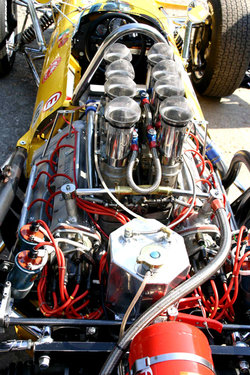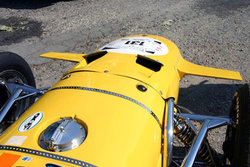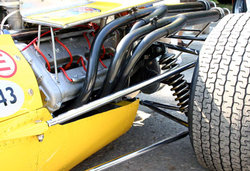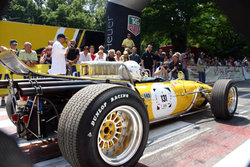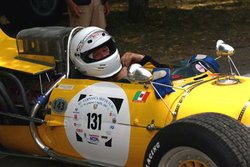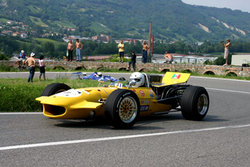Difference between revisions of "Serenissima"
m |
m |
||
| (41 intermediate revisions by the same user not shown) | |||
| Line 1: | Line 1: | ||
| − | + | {{X}} | |
| − | [[Image: | + | [[Image:Serenissimalogo.png|center|120px]] |
[[Image:1961 Ferrari 250 TR 61 Spyder Fantuzzi 34 left 2.jpg|right|thumb|350px|1961 [[Ferrari TR|Ferrari 250 TR]] modified by [[Giotto Bizzarrini]] for [[Count Giovanni Volpi|Volpi]]'s Scuderia Serenissima]] | [[Image:1961 Ferrari 250 TR 61 Spyder Fantuzzi 34 left 2.jpg|right|thumb|350px|1961 [[Ferrari TR|Ferrari 250 TR]] modified by [[Giotto Bizzarrini]] for [[Count Giovanni Volpi|Volpi]]'s Scuderia Serenissima]] | ||
| + | [[Image:Serenissimafront.jpg|thumb|250px|right|Serenissima 308 Jet Competizione]] | ||
| + | [[Image:Serenissimaback.jpg|thumb|250px|right|Serenissima 308 Jet Competizione]] | ||
| + | [[Image:SerenissimaAgena GT.jpg|thumb|250px|right|1969 Serenissima Agena GT (designed by [[Ghia]])]] | ||
| + | [[File:1966 Serenissima Jungla.jpg|thumb|right|250px|'''1966 Serenissima Jungla disigend by [[Bernhard Quentin]] and powered by a 3 Liter [[Alfa Romeo]] V8 engine''']] | ||
| − | '''Scuderia Serenissima''' was a successful [[auto racing]] team in the early [[1960s]]. Funded by [[Giovanni Volpi]], Serenissima used [[Ferrari]]s to much success until the founder financed the [[History of Ferrari#The great walkout|exiled Ferrari]] company, [[ | + | |
| + | '''Scuderia Serenissima''' was a successful [[auto racing]] team in the early [[1960s]]. Funded by [[Giovanni Volpi]], Serenissima used [[Ferrari]]s to much success until the founder financed the [[History of Ferrari#The great walkout|exiled Ferrari]] company, [[ATS]]. Thereafter, [[Enzo Ferrari]] would no longer sell his cars to Serenissima, so the company turned to [[De Tomaso]], ATS, and [[Maserati]]. | ||
In [[1963]], Volpi began developing his own prototype [[GT car]], the '''Jungla GT'''. It used a new [[V8]] engine, designed by [[Alberto Massimino]], with closed bodywork by [[Francesco Salomone]] (built by [[Gran Sport]]). A later open version was built by [[Fantuzzi]]. | In [[1963]], Volpi began developing his own prototype [[GT car]], the '''Jungla GT'''. It used a new [[V8]] engine, designed by [[Alberto Massimino]], with closed bodywork by [[Francesco Salomone]] (built by [[Gran Sport]]). A later open version was built by [[Fantuzzi]]. | ||
| − | |||
| − | |||
The company also developed [[Formula One]] cars, using [[Team McLaren|McLaren]] and [[Lola]] chassis. Another V8, developed by [[Jaguar Cars|Jaguar]], found its way into a single-seat closed sports car built by [[Carrozzeria Sports Cars]] in [[1969]]. The final Serenissima car was designed by [[Ghia]] that same year. Using the same Jaguar V8, the '''Aghema GT''' featured modern sharp styling, but never reached production. | The company also developed [[Formula One]] cars, using [[Team McLaren|McLaren]] and [[Lola]] chassis. Another V8, developed by [[Jaguar Cars|Jaguar]], found its way into a single-seat closed sports car built by [[Carrozzeria Sports Cars]] in [[1969]]. The final Serenissima car was designed by [[Ghia]] that same year. Using the same Jaguar V8, the '''Aghema GT''' featured modern sharp styling, but never reached production. | ||
| Line 16: | Line 19: | ||
| + | Serene in 1963 initiated the development of a sports car sponsored by [[Volpi]]. The project was carried out by [[Sasamotors]] of Modena and known as Jungle GT. | ||
| + | |||
| + | The engine and transmission were designed by [[Alberto Massimino]], it was a V8 2996cc engine with an output of approximately 300cv. | ||
| + | |||
| + | The first car, a coupe designed by [[Francesco Salomone]] and built by [[Great Sport]] of Modena, appeared in late 1964. | ||
| + | While the first car was still at an experimental stage, was built by [[Fantuzzi]] Modena in a second car. This second car had a 3495cc engine and an output of approximately 340cv. Later, this engine would be implanted in the original prototype. | ||
| + | Parallel to the construction of these cars, the company switched its activities with projects of Formula 1, using chassis from Lola and McLaren, and began development of another V8 engine, this time designed by Jaguar and three valves per cylinder. This engine was used in a new sports car for a single seat was built by [[Sport Car]] of Modena in 1969. | ||
| + | The latest model of Serenissima was designed by a passenger car built by [[Ghia]] and [[Sport Car]] of [[Modena]]. This car was christened with the name of Aghema GT V8 engine and used the three valves per cylinder above with a capacity of 3470cc and a power 320cv at 7500rpm. | ||
| − | == | + | The company withdrew from any involvement in the automobile sector in 1969. [http://www.autopasion18.com/HISTORIA-SERENISSIMA.htm <small>Source</small>] |
| − | [[Image:ser1a.jpg|thumb| | + | |
| + | |||
| + | == Gallery == | ||
| + | |||
| + | <gallery> | ||
| + | image:vd36.jpg|'''Serenissima Jet Competizione 1965. The nice small body very typical of the 60s looks like the Ferrari Le Mans.''' | ||
| + | image:vd37.jpg|'''1965 Serenissima Jet Competizione; the 8 cylinder V90 engine.''' | ||
| + | image:69 Serenissima F1 nose.jpg|'''1969 Serenissima F1 nose''' | ||
| + | image:69 Serenissima F1 chassis.jpg|'''1969 Serenissima F1 chassis''' | ||
| + | image:69 Serenissima F1 engine.jpg|'''1969 Serenissima F1 engine''' | ||
| + | image:serenissima3.jpg | ||
| + | </gallery> | ||
| + | |||
| + | |||
| + | == The Scuderia Serenissima Story == | ||
| + | [[Image:ser1a.jpg|thumb|right|250px]] | ||
| − | |||
In the early 1960s, the Scuderia Serenissima, founded by the Venetian Count Giovanni Volpi di Misurata, was very active in motor racing, entering major events with Porsches, a Lotus-Cooper, [[Maserati]]s, and [[Ferrari]]s driven by [[Nino Vaccarella]], [[Graham Hill]], [[Umberto Maglioli]], [[Joakim Bonnier]], [[Jo Siffert]], [[Lodovico Scarfiotti]] and [[Giancarlo Baghetti]]. | In the early 1960s, the Scuderia Serenissima, founded by the Venetian Count Giovanni Volpi di Misurata, was very active in motor racing, entering major events with Porsches, a Lotus-Cooper, [[Maserati]]s, and [[Ferrari]]s driven by [[Nino Vaccarella]], [[Graham Hill]], [[Umberto Maglioli]], [[Joakim Bonnier]], [[Jo Siffert]], [[Lodovico Scarfiotti]] and [[Giancarlo Baghetti]]. | ||
| Line 29: | Line 54: | ||
Scuderia Serenissima entered [[Formula 1]] events in 1961 with a Cooper-Maserati driven by [[Maurice Trintignant]]. For the [[French GP]], the team used a De Tomaso chassis powered by an [[OSCA]] engine, which was shared by [[Giorgio Scarlatti]] and [[Nino Vaccarella]]. However, the DeTomaso OSCAs were not competitive. After the great palace revolt at Maranello, Volpi employed Bizzarini, Chiti, Gardini, Selmi, Tavoni (all ex-Ferrari managers) and, together with the Italian industrialist Giorgio Billi and the young Bolivian Jaime Ortix Patino, founded [[ATS]]. | Scuderia Serenissima entered [[Formula 1]] events in 1961 with a Cooper-Maserati driven by [[Maurice Trintignant]]. For the [[French GP]], the team used a De Tomaso chassis powered by an [[OSCA]] engine, which was shared by [[Giorgio Scarlatti]] and [[Nino Vaccarella]]. However, the DeTomaso OSCAs were not competitive. After the great palace revolt at Maranello, Volpi employed Bizzarini, Chiti, Gardini, Selmi, Tavoni (all ex-Ferrari managers) and, together with the Italian industrialist Giorgio Billi and the young Bolivian Jaime Ortix Patino, founded [[ATS]]. | ||
The new company was located in Sasso Marconi and produced cars from 1962 until 1965. Volpi and Billi failed to work well together, the race car program was not a success, and the Count stopped the collaboration with [[ATS]]. | The new company was located in Sasso Marconi and produced cars from 1962 until 1965. Volpi and Billi failed to work well together, the race car program was not a success, and the Count stopped the collaboration with [[ATS]]. | ||
| + | |||
'''Serenissima Automobili''' | '''Serenissima Automobili''' | ||
| Line 34: | Line 60: | ||
In June 1965, Volpi, together with Valerio Berghinz and a few technicians, founded the Serenissima Automobili Company in [[Formigine]], near [[Modena]]. Volpi decided to build a mid-engined sportscar with a 3-liter V8 engine. The engine was designed by former Maserati chief engineer Alberto Massimino and was developed by Alf Francis, the legendary mechanic of Stirling Moss. In a short time, the tiny new company was able to develop a new racing car project including a Formula 1 car. | In June 1965, Volpi, together with Valerio Berghinz and a few technicians, founded the Serenissima Automobili Company in [[Formigine]], near [[Modena]]. Volpi decided to build a mid-engined sportscar with a 3-liter V8 engine. The engine was designed by former Maserati chief engineer Alberto Massimino and was developed by Alf Francis, the legendary mechanic of Stirling Moss. In a short time, the tiny new company was able to develop a new racing car project including a Formula 1 car. | ||
| − | [[Image:ser2.jpg|thumb| | + | [[Image:ser2.jpg|thumb|250px|right]] |
Despite the fact that the sports-car program was not a success, the increase in displacement to three liters in the 1966 Formula 1 regulations in 1966 provided an opportunity for the company. | Despite the fact that the sports-car program was not a success, the increase in displacement to three liters in the 1966 Formula 1 regulations in 1966 provided an opportunity for the company. | ||
Readers may recall that in 1966, the McLaren Team, founded by Bruce McLaren, began its F1 career at Monaco. Bruce started with the new M2B-2, which had a chassis designed by Robin Herd and a Traco-Ford Indy engine. Contemplating the need for a new engine, McLaren spoke to count Volpi who was able to supply a Serenissima V8 engine. | Readers may recall that in 1966, the McLaren Team, founded by Bruce McLaren, began its F1 career at Monaco. Bruce started with the new M2B-2, which had a chassis designed by Robin Herd and a Traco-Ford Indy engine. Contemplating the need for a new engine, McLaren spoke to count Volpi who was able to supply a Serenissima V8 engine. | ||
| + | |||
'''McLaren-Serenissima''' | '''McLaren-Serenissima''' | ||
| Line 43: | Line 70: | ||
In June 1966, the engine (type M166) was taken out from the ‘Serenissima Jet competizione’ and Bruce worked personally on the car to install the Serenissima V8 in the McLaren. The M166 engine, known also as a 308 engine (3 liters, 8 cylinders), was a 90 degree V8 engine and had chain driven twin overhead camshafts on each bank. Bore and stroke was 85 mm x 66 mm, capacity was 2996 cc. And, with a compression ratio of 9.75:1, the Serenissima V8 power unit developed a power output of 305-307 bhp at 8500 rpm. | In June 1966, the engine (type M166) was taken out from the ‘Serenissima Jet competizione’ and Bruce worked personally on the car to install the Serenissima V8 in the McLaren. The M166 engine, known also as a 308 engine (3 liters, 8 cylinders), was a 90 degree V8 engine and had chain driven twin overhead camshafts on each bank. Bore and stroke was 85 mm x 66 mm, capacity was 2996 cc. And, with a compression ratio of 9.75:1, the Serenissima V8 power unit developed a power output of 305-307 bhp at 8500 rpm. | ||
| − | [[Image:ser3.jpg|thumb| | + | [[Image:ser3.jpg|thumb|250px|left]] |
The McLaren-Serenissima headed for the [[Grand Prix of Belgium]] on June 12th. In practice, the engine blew when its bearings failed. Better luck would be had at the British GP on July 16th, with Bruce and the McLaren-Serenissima finishing 6th behind Brabham, Hulme, Hill, Clark and Rindt. | The McLaren-Serenissima headed for the [[Grand Prix of Belgium]] on June 12th. In practice, the engine blew when its bearings failed. Better luck would be had at the British GP on July 16th, with Bruce and the McLaren-Serenissima finishing 6th behind Brabham, Hulme, Hill, Clark and Rindt. | ||
On this memorable day, Bruce McLaren, after starting from thirteenth on the grid, won the first point for his team and, with this World Championship point, Serenissima became part of the annals of Formula 1 engine constructors. | On this memorable day, Bruce McLaren, after starting from thirteenth on the grid, won the first point for his team and, with this World Championship point, Serenissima became part of the annals of Formula 1 engine constructors. | ||
| + | [[Image:ser4.jpg|thumb|250px|right]] | ||
On July 23th, Bruce tried to qualifie the McLaren M2B-2 for the Dutch GP, but the car failed with engine trouble, so McLaren decided that he best continue with the development of the Ford engine. | On July 23th, Bruce tried to qualifie the McLaren M2B-2 for the Dutch GP, but the car failed with engine trouble, so McLaren decided that he best continue with the development of the Ford engine. | ||
| Line 55: | Line 83: | ||
In early 1967, in Formigine, Alf Francis redesigned and modified the chassis and installed a Serenissima-V8 engine with new cylinder heads. At the same time, in Modena, Medardo Fantuzzi and his son made a new body. It was the first F1 with ‘wings’, an aerodynamics idea that derived from Carlo Chiti and Fantuzzi. Thus was born a new F1 car that was given the nomenclature ‘M1AF’ ("M1 for McLaren – chassis 1, and "AF" for Alf Francis). | In early 1967, in Formigine, Alf Francis redesigned and modified the chassis and installed a Serenissima-V8 engine with new cylinder heads. At the same time, in Modena, Medardo Fantuzzi and his son made a new body. It was the first F1 with ‘wings’, an aerodynamics idea that derived from Carlo Chiti and Fantuzzi. Thus was born a new F1 car that was given the nomenclature ‘M1AF’ ("M1 for McLaren – chassis 1, and "AF" for Alf Francis). | ||
| + | [[Image:ser5.jpg|thumb|left|250px]] | ||
On February 22nd, the Italian magazine ‘Autosprint’ reported on the new car. In the article, the writer stated that the driver of Serenissima F1 may be Bussinello and plans were made to enter the car in the next Siracusa and Monte Carlo Grand Prix. The new car had a short test at the Aerodrome of Modena, where it was driven by Mike Parkes, Lodovico Scarfiotti, Bruce McLaren and Alf Francis himself. | On February 22nd, the Italian magazine ‘Autosprint’ reported on the new car. In the article, the writer stated that the driver of Serenissima F1 may be Bussinello and plans were made to enter the car in the next Siracusa and Monte Carlo Grand Prix. The new car had a short test at the Aerodrome of Modena, where it was driven by Mike Parkes, Lodovico Scarfiotti, Bruce McLaren and Alf Francis himself. | ||
During 1968 Count Volpi pulled out once again, and short of money, the project soon came to a halt. For a long time, no one had any interest in the car. Later, it made an appearance at Monza during the 1969 Italian GP on September 5-7th, as part of a racecar exhibition. | During 1968 Count Volpi pulled out once again, and short of money, the project soon came to a halt. For a long time, no one had any interest in the car. Later, it made an appearance at Monza during the 1969 Italian GP on September 5-7th, as part of a racecar exhibition. | ||
| + | [[Image:ser6.jpg|thumb|right|250px]] | ||
Some time before, on July 17th, the Italian magazines ‘Auto Italiana’ and ‘Autosprint’ speculated that the Serenissima F1 might be revived using a new type of 358 engine and it was possible that the Serenissima single seater could be raced in an F1 or F libre event. | Some time before, on July 17th, the Italian magazines ‘Auto Italiana’ and ‘Autosprint’ speculated that the Serenissima F1 might be revived using a new type of 358 engine and it was possible that the Serenissima single seater could be raced in an F1 or F libre event. | ||
The new 358 engine (3.5 liters, 8 cylinders), built entirely in aluminum, was a development of the 308 and had a new crankshaft. Bore and stroke was 91.5 mm x 66 mm, capacity was 3471cc and, with a compression ratio of 12:1, this new Serenissima V8 power unit developed an output of 380 bhp at 8900 rpm. | The new 358 engine (3.5 liters, 8 cylinders), built entirely in aluminum, was a development of the 308 and had a new crankshaft. Bore and stroke was 91.5 mm x 66 mm, capacity was 3471cc and, with a compression ratio of 12:1, this new Serenissima V8 power unit developed an output of 380 bhp at 8900 rpm. | ||
| + | [[Image:ser7.jpg|thumb|left|250px]] | ||
In the summer of 1969, the Serenissima F1, powered by the 358 engine, was tested at the Aerodrome of Modena, driven by the Austrian driver Egon von Pump-Hofer. Hofer was very satisfied with the car and decided to acquire it. On October 29th, Hofer shipped it to Austria. | In the summer of 1969, the Serenissima F1, powered by the 358 engine, was tested at the Aerodrome of Modena, driven by the Austrian driver Egon von Pump-Hofer. Hofer was very satisfied with the car and decided to acquire it. On October 29th, Hofer shipped it to Austria. | ||
Hofer drove the Serenissima in a few exhibitions, and on May 3rd, 1970, entered the car in the Group 9 (renwagen formelfrei) class in the Alpl-Hillclimb. The ‘Alpl-Berg-Rennen’ was promoted as an international event for cars and motorcycles. Unfortunately, today, the German FIA organization (ASN) does not accept this race as an FIA international event. | Hofer drove the Serenissima in a few exhibitions, and on May 3rd, 1970, entered the car in the Group 9 (renwagen formelfrei) class in the Alpl-Hillclimb. The ‘Alpl-Berg-Rennen’ was promoted as an international event for cars and motorcycles. Unfortunately, today, the German FIA organization (ASN) does not accept this race as an FIA international event. | ||
| + | [[Image:ser10.jpg|thumb|right|250px]] | ||
| + | |||
'''Lost and Found''' | '''Lost and Found''' | ||
| Line 72: | Line 105: | ||
In 1971, Hofer decided to sell the Serenissima and placed an ad in the magazine ‘Autosport’. At this time, Hofer believed that the Serenissima was a 1969 car, because he had bought it in 1969, and the presence of ‘wings’ on the car was similar to the others cars of the period. In 1972 the car was sold to a collector and, from 1973 to 1981, the Serenissima changed hands often. Finally, the father of the current owner bought the Serenissima on March 24th, 1982, from a Ferrari dealer in Stuttgart. | In 1971, Hofer decided to sell the Serenissima and placed an ad in the magazine ‘Autosport’. At this time, Hofer believed that the Serenissima was a 1969 car, because he had bought it in 1969, and the presence of ‘wings’ on the car was similar to the others cars of the period. In 1972 the car was sold to a collector and, from 1973 to 1981, the Serenissima changed hands often. Finally, the father of the current owner bought the Serenissima on March 24th, 1982, from a Ferrari dealer in Stuttgart. | ||
| + | [[Image:ser8.jpg|thumb|left|250px]] | ||
The car was in very bad condition and was parked on a euro pallet in the back of a shack, where it had been forgotten. The new owner also left the Serenissima in a shack, until, one day, many years later, his son Nicholas found it. It was the beginning of a great love. Nicholas began the restoration without his father’s knowledge. Two years later, on his wedding day in 1994, Nicholas completed the restoration and the Serenissima M1AF was in perfect condition. Then, from 2005, the Serenissima participated to some events reserved for the vintage F1 cars at [[Spa]], [[Salzburgring]], [[Most]], [[Zolder]], [[Hockenheim]], [[Donington]], and the [[Nurburgring]]. | The car was in very bad condition and was parked on a euro pallet in the back of a shack, where it had been forgotten. The new owner also left the Serenissima in a shack, until, one day, many years later, his son Nicholas found it. It was the beginning of a great love. Nicholas began the restoration without his father’s knowledge. Two years later, on his wedding day in 1994, Nicholas completed the restoration and the Serenissima M1AF was in perfect condition. Then, from 2005, the Serenissima participated to some events reserved for the vintage F1 cars at [[Spa]], [[Salzburgring]], [[Most]], [[Zolder]], [[Hockenheim]], [[Donington]], and the [[Nurburgring]]. | ||
| + | [[Image:ser9.jpg|thumb|right|250px]] | ||
Today, 40 years after its first shake-down run, the M1AF has proven fascinating the public in all the events it has entered. The Serenissima M1 AF is an interesting car which was never used in an F1-World Championship, but we respect its authenticity. Even though there are no doubts about its history, there are still some mysteries. Now, after decades of oblivion it can be seen as a very unique Italian [[Formula 1]]. | Today, 40 years after its first shake-down run, the M1AF has proven fascinating the public in all the events it has entered. The Serenissima M1 AF is an interesting car which was never used in an F1-World Championship, but we respect its authenticity. Even though there are no doubts about its history, there are still some mysteries. Now, after decades of oblivion it can be seen as a very unique Italian [[Formula 1]]. | ||
| + | [http://www.velocetoday.com <small>Source</small>] | ||
| + | ''Story and photography by Roberto Motta'' | ||
| − | |||
| + | {{Formula One constructors}} | ||
| + | {{-}} | ||
| + | {{A-Z multipage list|Car Information and Photos by Marque|Information and Photos by Marque|}} | ||
| + | {{A-Z multipage list|Motorcycle Information and Photos by Marque|Motorcycle Information and Photos by Marque|}} | ||
| + | {{Car Information and Photos by Marque}} | ||
| + | {{Motorcycle Information and Photos by Marque}} | ||
[[Category:Motor vehicle manufacturers of Italy|Serenissima]] | [[Category:Motor vehicle manufacturers of Italy|Serenissima]] | ||
[[Category:Ferrari|Serenissima]] | [[Category:Ferrari|Serenissima]] | ||
[[Category:Formula One constructors|Serenissima]] | [[Category:Formula One constructors|Serenissima]] | ||
| − | |||
| − | |||
| − | |||
| − | |||
| − | |||
| − | |||
| − | |||
| − | |||
| − | |||
| − | |||
Latest revision as of 06:42, 9 June 2012
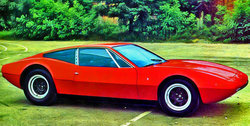
Scuderia Serenissima was a successful auto racing team in the early 1960s. Funded by Giovanni Volpi, Serenissima used Ferraris to much success until the founder financed the exiled Ferrari company, ATS. Thereafter, Enzo Ferrari would no longer sell his cars to Serenissima, so the company turned to De Tomaso, ATS, and Maserati.
In 1963, Volpi began developing his own prototype GT car, the Jungla GT. It used a new V8 engine, designed by Alberto Massimino, with closed bodywork by Francesco Salomone (built by Gran Sport). A later open version was built by Fantuzzi.
The company also developed Formula One cars, using McLaren and Lola chassis. Another V8, developed by Jaguar, found its way into a single-seat closed sports car built by Carrozzeria Sports Cars in 1969. The final Serenissima car was designed by Ghia that same year. Using the same Jaguar V8, the Aghema GT featured modern sharp styling, but never reached production.
Volpi, and thus Serenissima, halted automobile operations before 1970.
Serene in 1963 initiated the development of a sports car sponsored by Volpi. The project was carried out by Sasamotors of Modena and known as Jungle GT.
The engine and transmission were designed by Alberto Massimino, it was a V8 2996cc engine with an output of approximately 300cv.
The first car, a coupe designed by Francesco Salomone and built by Great Sport of Modena, appeared in late 1964.
While the first car was still at an experimental stage, was built by Fantuzzi Modena in a second car. This second car had a 3495cc engine and an output of approximately 340cv. Later, this engine would be implanted in the original prototype.
Parallel to the construction of these cars, the company switched its activities with projects of Formula 1, using chassis from Lola and McLaren, and began development of another V8 engine, this time designed by Jaguar and three valves per cylinder. This engine was used in a new sports car for a single seat was built by Sport Car of Modena in 1969.
The latest model of Serenissima was designed by a passenger car built by Ghia and Sport Car of Modena. This car was christened with the name of Aghema GT V8 engine and used the three valves per cylinder above with a capacity of 3470cc and a power 320cv at 7500rpm.
The company withdrew from any involvement in the automobile sector in 1969. Source
Gallery
The Scuderia Serenissima Story
In the early 1960s, the Scuderia Serenissima, founded by the Venetian Count Giovanni Volpi di Misurata, was very active in motor racing, entering major events with Porsches, a Lotus-Cooper, Maseratis, and Ferraris driven by Nino Vaccarella, Graham Hill, Umberto Maglioli, Joakim Bonnier, Jo Siffert, Lodovico Scarfiotti and Giancarlo Baghetti.
Scuderia Serenissima entered Formula 1 events in 1961 with a Cooper-Maserati driven by Maurice Trintignant. For the French GP, the team used a De Tomaso chassis powered by an OSCA engine, which was shared by Giorgio Scarlatti and Nino Vaccarella. However, the DeTomaso OSCAs were not competitive. After the great palace revolt at Maranello, Volpi employed Bizzarini, Chiti, Gardini, Selmi, Tavoni (all ex-Ferrari managers) and, together with the Italian industrialist Giorgio Billi and the young Bolivian Jaime Ortix Patino, founded ATS. The new company was located in Sasso Marconi and produced cars from 1962 until 1965. Volpi and Billi failed to work well together, the race car program was not a success, and the Count stopped the collaboration with ATS.
Serenissima Automobili
In June 1965, Volpi, together with Valerio Berghinz and a few technicians, founded the Serenissima Automobili Company in Formigine, near Modena. Volpi decided to build a mid-engined sportscar with a 3-liter V8 engine. The engine was designed by former Maserati chief engineer Alberto Massimino and was developed by Alf Francis, the legendary mechanic of Stirling Moss. In a short time, the tiny new company was able to develop a new racing car project including a Formula 1 car.
Despite the fact that the sports-car program was not a success, the increase in displacement to three liters in the 1966 Formula 1 regulations in 1966 provided an opportunity for the company. Readers may recall that in 1966, the McLaren Team, founded by Bruce McLaren, began its F1 career at Monaco. Bruce started with the new M2B-2, which had a chassis designed by Robin Herd and a Traco-Ford Indy engine. Contemplating the need for a new engine, McLaren spoke to count Volpi who was able to supply a Serenissima V8 engine.
McLaren-Serenissima
In June 1966, the engine (type M166) was taken out from the ‘Serenissima Jet competizione’ and Bruce worked personally on the car to install the Serenissima V8 in the McLaren. The M166 engine, known also as a 308 engine (3 liters, 8 cylinders), was a 90 degree V8 engine and had chain driven twin overhead camshafts on each bank. Bore and stroke was 85 mm x 66 mm, capacity was 2996 cc. And, with a compression ratio of 9.75:1, the Serenissima V8 power unit developed a power output of 305-307 bhp at 8500 rpm.
The McLaren-Serenissima headed for the Grand Prix of Belgium on June 12th. In practice, the engine blew when its bearings failed. Better luck would be had at the British GP on July 16th, with Bruce and the McLaren-Serenissima finishing 6th behind Brabham, Hulme, Hill, Clark and Rindt. On this memorable day, Bruce McLaren, after starting from thirteenth on the grid, won the first point for his team and, with this World Championship point, Serenissima became part of the annals of Formula 1 engine constructors.
On July 23th, Bruce tried to qualifie the McLaren M2B-2 for the Dutch GP, but the car failed with engine trouble, so McLaren decided that he best continue with the development of the Ford engine. Meanwhile, back in Italy, by September 1966, the Serenissima M166 engine was rebuilt with new bore and stroke (91.5 x 57 mm, capacity was 2998.46 cc) and became the M167. The M1AF At the end of the 1966 season, for the payment of the use of the Serenissima engine, McLaren delivered a chassis to Count Volpi, probably an M2B-2 chassis, because it arrived with perfect engine mounts for the Serenissima engine. In early 1967, in Formigine, Alf Francis redesigned and modified the chassis and installed a Serenissima-V8 engine with new cylinder heads. At the same time, in Modena, Medardo Fantuzzi and his son made a new body. It was the first F1 with ‘wings’, an aerodynamics idea that derived from Carlo Chiti and Fantuzzi. Thus was born a new F1 car that was given the nomenclature ‘M1AF’ ("M1 for McLaren – chassis 1, and "AF" for Alf Francis).
On February 22nd, the Italian magazine ‘Autosprint’ reported on the new car. In the article, the writer stated that the driver of Serenissima F1 may be Bussinello and plans were made to enter the car in the next Siracusa and Monte Carlo Grand Prix. The new car had a short test at the Aerodrome of Modena, where it was driven by Mike Parkes, Lodovico Scarfiotti, Bruce McLaren and Alf Francis himself. During 1968 Count Volpi pulled out once again, and short of money, the project soon came to a halt. For a long time, no one had any interest in the car. Later, it made an appearance at Monza during the 1969 Italian GP on September 5-7th, as part of a racecar exhibition.
Some time before, on July 17th, the Italian magazines ‘Auto Italiana’ and ‘Autosprint’ speculated that the Serenissima F1 might be revived using a new type of 358 engine and it was possible that the Serenissima single seater could be raced in an F1 or F libre event. The new 358 engine (3.5 liters, 8 cylinders), built entirely in aluminum, was a development of the 308 and had a new crankshaft. Bore and stroke was 91.5 mm x 66 mm, capacity was 3471cc and, with a compression ratio of 12:1, this new Serenissima V8 power unit developed an output of 380 bhp at 8900 rpm.
In the summer of 1969, the Serenissima F1, powered by the 358 engine, was tested at the Aerodrome of Modena, driven by the Austrian driver Egon von Pump-Hofer. Hofer was very satisfied with the car and decided to acquire it. On October 29th, Hofer shipped it to Austria. Hofer drove the Serenissima in a few exhibitions, and on May 3rd, 1970, entered the car in the Group 9 (renwagen formelfrei) class in the Alpl-Hillclimb. The ‘Alpl-Berg-Rennen’ was promoted as an international event for cars and motorcycles. Unfortunately, today, the German FIA organization (ASN) does not accept this race as an FIA international event.
Lost and Found
In 1971, Hofer decided to sell the Serenissima and placed an ad in the magazine ‘Autosport’. At this time, Hofer believed that the Serenissima was a 1969 car, because he had bought it in 1969, and the presence of ‘wings’ on the car was similar to the others cars of the period. In 1972 the car was sold to a collector and, from 1973 to 1981, the Serenissima changed hands often. Finally, the father of the current owner bought the Serenissima on March 24th, 1982, from a Ferrari dealer in Stuttgart.
The car was in very bad condition and was parked on a euro pallet in the back of a shack, where it had been forgotten. The new owner also left the Serenissima in a shack, until, one day, many years later, his son Nicholas found it. It was the beginning of a great love. Nicholas began the restoration without his father’s knowledge. Two years later, on his wedding day in 1994, Nicholas completed the restoration and the Serenissima M1AF was in perfect condition. Then, from 2005, the Serenissima participated to some events reserved for the vintage F1 cars at Spa, Salzburgring, Most, Zolder, Hockenheim, Donington, and the Nurburgring.
Today, 40 years after its first shake-down run, the M1AF has proven fascinating the public in all the events it has entered. The Serenissima M1 AF is an interesting car which was never used in an F1-World Championship, but we respect its authenticity. Even though there are no doubts about its history, there are still some mysteries. Now, after decades of oblivion it can be seen as a very unique Italian Formula 1. Source
Story and photography by Roberto Motta
| Car Information and Photos by Marque: A - B - C - D - E - F - G - H - I - J - K - L - M - N - O - P - Q - R - S - T - U - V - W - X - Y - Z |
| Motorcycle Information and Photos by Marque: A - B - C - D - E - F - G - H - I - J - K - L - M - N - O - P - Q - R - S - T - U - V - W - X - Y - Z |

